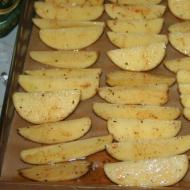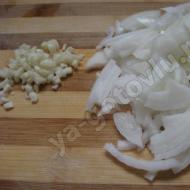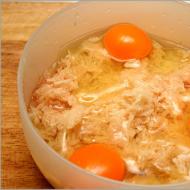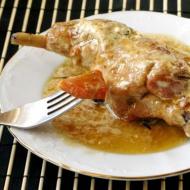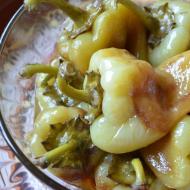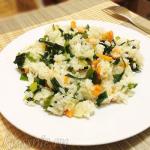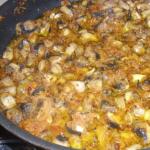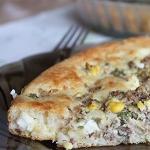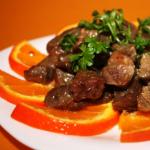
Russian national salad "Olivier" in the history of Russia. The very first and original recipe for the real Olivier Olivier Wiki
On the eve of the New Year holidays, we want to tell you about the history of the main decoration of the festive table - Olivier salad. Not a single New Year's feast can do without this culinary masterpiece, it was prepared by our grandmothers and mothers, it is he who is our official taste of the New Year. And it all started in a very Russian way…
Photo © culture.ru
Venue - tavern "Hermitage"
The original Olivier salad recipe was invented by a French chef in the 60s of the 19th century, this man's name was Lucien Olivier. In addition to the fact that Lucien was an excellent cook, he was also the owner of the Hermitage Moscow tavern, which was located on Trubnaya Square, at the corner of Petrovsky Boulevard and Neglinnaya Street. It may be familiar to contemporaries as the building of the Moscow theater "School of Modern Play". The restaurant was open from 11 am to 4 am. About 60 chefs prepared food here, and the daily revenue was 2 thousand rubles a day, which was comparable to the budget of a small town.
In the 1860s, the inn was popular and was a real Parisian restaurant. Richly decorated with stucco, crystal chandeliers and bronze, with private booths and excellent French-Russian cuisine, the restaurant has become a favorite vacation spot for the Moscow beau monde. It was within these walls that the chef Lucien Olivier introduced the discerning public to the cold mayon sauce, which was unprecedented at that time - the ancestor of modern mayonnaise.
The nobility poured into the new French restaurant, where, in addition to the common rooms and offices, there was a white columned hall in which you could order the same dinners that Olivier did in the mansions of the nobles. For these dinners, delicacies from abroad and the best wines were also ordered, with a certificate that this cognac was from the cellars of the palace of Louis XVI, and with the inscription "Trianon"- V.A. Gilyarovsky "Moscow and Muscovites".

Photo © pastvu.com/Iskra magazine No. 28, 1907
game mayonnaise
After some time, the requests of the guests began to grow, the visitors demanded a new menu. In order to return the former glory to his tavern, as the abode of all the cream of society, Lucien came up with a completely new dish - an unusual author's Olivier salad. The new work of culinary art not only justified its purpose, but also confidently entered the annals of history, remaining today an indispensable recipe for a festive feast.
It is important to note that initially the chef did not set himself the goal of inventing a salad. The French soul demanded something gourmet, so initially his dish appeared under the name "Mayonnaise from the game." Its initial composition included well-boiled, sliced aspic meat of hazel grouse and partridge, and as a decoration, crayfish necks boiled in a spicy broth and slices of boiled tongue were added. This whole grandiose meat still life was flavored with Provencal sauce, prepared on the basis of the usual mayon, and diced boiled potatoes, gherkins and boiled eggs were placed in the center of the exposition.

The Frenchman soon noticed that visitors to the Hermitage were not much inspired by this segregation. On the contrary, due to the simplicity of their souls, they mix all the contents of the plate together, and with great pleasure they eat a newfangled dish, spoiling the original beauty and idea of the author's presentation.
After this observation, Olivier did not bother with the lengthy decoration of his signature dish, but greatly facilitated the cooking procedure. He acted extremely simply: he crushed and mixed all the ingredients, generously filling them with crown sauce. So the Olivier salad saw the light.
Today we can find a dozen variants of the resourceful French salad recipe. But, naturally, the original formula and cooking technology of Olivier was strictly classified at that time, and one could taste a real dish according to a classic recipe only in the Hermitage tavern.
Many chefs puzzled over insoluble questions, in what proportions to mix the ingredients and how the main detail of the salad is made - Lucien Olivier's flawless sauce? Immediately after the deafening premiere of the new dish, many culinary minds in Moscow tried to experimentally repeat the original recipe for the legendary snack, but they all failed. And Lucien continued to calculate profits and prepare his popular salad.

Photo © auction.ru
After the death of the chef, the history of the Olivier salad began to acquire secrets and it was believed that the secret of the famous real salad was lost. The grave of the famous cook at the Vvedensky cemetery became a place of pilgrimage for cooks and restaurateurs of that time. Rumor has it that some of them tried to use occult practices in order to uncover the secret of a popular recipe.

Photo © Alexander Krivonosov
Recipe Mystery
Of course, there were many attempts to unravel the Frenchman's signature recipe, but all attempts were unsuccessful. But, thanks to endless gastronomic experiences, many new cold dishes and variations of salads a la Olivier have appeared. One of these samples turned into the Stolichny salad, the recipe of which today is passed off as the classic Olivier. Lucien Olivier kept his own recipe in the strictest confidence, because that is why more and more visitors came to try his "secret" dish.

According to some assumptions, this is exactly what the classic, the only correct recipe for Olivier salad from the creator looked like. True, over time, Lucien himself made some changes to his original recipe, but in the end the composition of the snack became as follows:
Fritillaries - 2 birds;
Tongue of a young heifer - ½ piece;
Pressed sturgeon caviar - 100 g;
Lettuce leaves - 180 g;
Crayfish - 20-25 pieces;
Gherkins - 200 g;
Sauce "Kabul" - 60 g;
Fresh cucumber - 2 pcs.;
Capers - 0.1 kg;
Boiled chicken eggs - 5 pcs.;
For the Provence sauce:
Olive oil - 0.4 l;
Raw egg yolks - 2 pcs.;
French vinegar - to taste;
Mustard - 2-3 tablespoons;
A funny and little-known detail, but when preparing Provence sauce, Lucien Olivier varied the amount of mustard depending on the amount of alcohol consumed by visitors. The drunker the audience, the sharper the mayonnaise. For non-drinking guests, Olivier salad was served with the most delicate dressing so that they could appreciate all its charm.

Salad a la "Olivier"
After the events of 1917, after the First World War, many products became an unaffordable luxury for most establishments. This gave impetus to the chefs of the “new era” to embark on a “culinary fever” in search of an alternative recipe for the famous Olivier salad.
The original recipe remained a secret, so the task of the culinary specialists was only to create a new salad, vaguely reminiscent of that legendary treat from the tavern on the Pipe. So, in 1920, the salad recipe a la Olivier looked like in the Moscow restaurant:
Boiled vegetables (6 potatoes and 3 carrots), pickled cucumbers (2 pcs.), 250 g of chicken and 3 eggs, should be cut into neat cubes. Onion (1 head) must be finely chopped.Salt and pepper all the finished cuts and 1 cup of green peas to taste, then mix with mayonnaise (170 g). When serving, garnish a portion of salad with parsley and green apple slices.

Photo © fb.ru
By the 1930s, the chef of the same "Moscow" again turned to the original recipe, and, having made a couple of author's amendments, called the resulting dish a new name - Stolichny salad. Until the 1950s, Stolichny held a leading position among the main Soviet treats. A set of ingredients for its preparation:
Game - 50 g;
Fresh cucumber - 40 g;
Lettuce green leaves - 10 g;
Boiled potatoes - 60 g;
Cancer fillet boiled - 10 g;
Boiled egg - 40 g;
Gherkins - 10 g;
Olives - 10 g;
"Southern" spicy sauce - 1 tablespoon;
Mayonnaise - 1/3 tbsp.;
Salt - to taste;
Today's salad "Olivier" is more than just a salad, no matter what name it comes up with. Surprisingly, today he personifies the New Year's mood, and even unites entire families around him. Cook with pleasure, and most importantly - with soul, because this, perhaps, is the very secret ingredient of Lucien Olivier.
Text © Sasha Vladinets / "Moscow is changing"
The winter New Year and Christmas holidays are approaching us at a very fast pace. Is it possible to imagine any winter holiday in our area without the traditional Olivier salad? True, it is impossible, because for many years and several generations this salad itself has become one of the integral attributes of New Year's (and all sorts of different) celebrations, even fit into our collective subconscious. But what is the history of this salad so beloved by everyone, what was it made from before and how has it changed over the years, read about all this further.
Olivier salad owes its name and at the same time its appearance to the talented French chef Lucien Olivier. At one time (it was back in the 19th century), this gentleman worked in Moscow on Trubnaya Square as the chief chef in the Hermitage tavern. But do not be surprised at the word "tavern", in fact it was not a tavern in the classical sense (as a place where local drunkards gather to have a good walk), but a real high-quality French restaurant, which was very fond of any sophisticated audience of that time - Russian aristocrats, rich merchants and landowners. To please his demanding customers, Mr. (or rather Monsieur) Olivier came up with new interesting dishes, experimented with various products in every possible way. As you may have guessed, the most outstanding result of his culinary experiments was the appearance of Olivier salad. But this masterpiece did not appear immediately.
First, Lucien Olivier came up with a dish called "game mayonnaise", for the preparation of which, the dish was served with pieces of fillet of hazel grouse and partridge mixed with cubes of jelly from the broth. Nearby lay boiled crayfish necks, poured with a special sauce, and in the center was a small mountain of potatoes with pickled artichokes, garnished with chopped eggs, which were not really intended for food, but were only an element of aesthetic decor.
One day, the great chef saw how one of the visitors to the restaurant, a fat landowner who loved to eat well, without ulterior (and even more so aesthetic) thoughts, simply took and mixed all the ingredients (including those that were only for decoration) and instantly ate everything. According to his satisfied face, Olivier decided to repeat this “feat” and the next day he mixed all the ingredients, and even watered them well with mayonnaise ... This is how the salad “of all times and peoples” appeared - Olivier.
But the first Olivier salad, of course, was not at all the way we know it today, but as historical sources say, it was even tastier! Still, for its preparation at the beginning, not some kind of boiled sausage was used, but real hazel grouses, partridges, crayfish necks, in a word, “aristocratic” ingredients, little accessible to ordinary people (how can one not recall the famous Soviet poet Mayakovsky with his winged: "eat pineapples, chew grouse, your last day comes bourgeois"). And indeed, the then Russian "bourgeois" (late 19th - early 20th century), eating an exquisite (and real!) Olivier salad of grouse and partridge, did not even know that they were chic in recent years, because very soon in 1917 a certain V. Lenin organizes his bloody Bolshevik coup, which Soviet historians would later call the "Great October Revolution."
But back to the Olivier salad, after its invention, it immediately became Monsieur Lucien's trademark, and was in great demand among restaurant visitors. Lucien Olivier kept the recipe for the salad in deep secrecy until the end of his days, and only after his death did it appear on the pages of Our Food magazine for March 1894. Here he is:
Fritillaries - ½ pieces. Potatoes - 3 pieces. Cucumbers - 1 piece. Salad - 3-4 sheets. Mayonnaise Provencal - 1 ½ table. spoons. Cancer necks - 3 pieces. Lanspic - ¼ cup. Capers - 1 teaspoon. Olives - 3-5 pieces. Cooking rules: Cut the fillet of a well-fried hazel grouse and mix with boiled, not crumbly potato blankets and slices of fresh cucumbers, add capers and olives and pour over a large amount of Provencal mayonnaise, with the addition of soy kabul. After cooling, transfer to a crystal vase, arrange with crayfish tails, lettuce leaves and chopped lanspic. Serve very cold. Fresh cucumbers can be replaced with large gherkins. Instead of grouse, you can take veal or chicken, but a real Olivier salad is prepared without fail from grouse.
Now, it's time to go to the store for grouse to feel the taste of real Olivier, as it was prepared before the October Revolution, in the 19th century. With the advent of the scoop, everything changed dramatically: expensive and rare ingredients were replaced by more familiar and cheap ones, boiled sausage instead of hazel grouse, green peas instead of crayfish necks. In the end, it was in the Soviet era that the Olivier salad was formed, which we know to this day, and which, I hope, we will certainly prepare very soon. (Maybe this article will inspire some of our readers to cook a real Olivier?) As for the salad itself, it seems that the secret of its such great popularity is in the simplicity of preparation (everything is ingenious - simple, isn't it?) And the relative accessibility of all ingredients in the winter, unlike many "summer" salads, which are unlikely to be prepared in winter. In conclusion, I wish you all happy holidays and delicious Olivier (with or without grouse).
And most often observed on the faces of surprise. Here is such a paradox: this salad, invented by one of the representatives of the famous French culinary dynasty, is a Russian national dish.
The famous salad appeared in the 60s of the XIX century thanks to the excellent chef Lucien Olivier, who moved from France to Russia. He became the owner of the famous Moscow restaurant Hermitage on Trubnaya Square. The place was the most pretentious, with European chic and Russian helpfulness (the waiters were dressed like tavern sex workers, only all the uniforms were sewn from expensive fabric ordered, for example, in Holland). The audience was appropriate, and the cuisine was one of the most famous in the capital.
The well-known everyday writer of Moscow in his book “Moscow and Muscovites”, of course, could not ignore the “Hermitage”, talking about this institution in the essay “On the Pipe” - that’s what the people called Trubnaya Square in those days. And about the famous Frenchman and his salad, Gilyarovsky wrote: “It was considered a special chic when dinners were prepared by the French chef Olivier, who even then became famous for the “Olivier salad” invented by him, without which dinner is not at lunch and whose secret he did not reveal. No matter how hard the gourmets tried, it didn’t work out: this, but not that. ” Alas, the original salad recipe remained unknown: Olivier died without revealing the secret ingredients of this dish. We got only a recipe restored by one of the Hermitage regulars based on personal observations and taste sensations.
Russian barbarians
Ironically, they say that Olivier invented his salad out of anger. And it was like that. The chef decided to please the visitors of the Hermitage with a new dish called Game Mayonnaise. It was a real culinary composition: diced lanspic, veal tongue and crayfish necks, sprinkled with Provencal mayonnaise. And in the center of this platter, mostly for decoration, was a pile of potatoes and gherkins, topped with boiled eggs.
But the Russians appreciated not so much the aesthetic as the taste of the dish: in front of the wounded Frenchman, visitors mixed vegetables with game, turning a culinary masterpiece into a kind of hearty salad. The next day, an angry Olivier expressed his "fee" in relation to such barbarism, mixing all the ingredients himself and pouring sauce over them. For which many thanks to him!
Imitation of Olivier
As you know, one of the tasks of the revolutionary movement was the program of ridding the Soviet people of all sorts of bourgeois survivals. And even more so from such a whim as aesthetics. In a word, people were not up to harmonious combinations of tastes of salad ingredients. So for almost 50 years they forgot about Olivier, and then he suddenly appeared in the center as a symbol of prosperity in a crystal salad bowl. A delicious, beloved by everyone, but outrageously simplified version of the once legendary salad, which was enjoyed by the color of the Moscow public, with sausage and terribly scarce mayonnaise and green peas ...
Terminology issues
The kabul sauce (or soy kabul) provided in the recipe is a kind of spicy seasoning. And, apparently, the product called "soy" has nothing to do with it. There are at least three opinions about what it is. Someone says that Yuzhny tomato sauce, which was prepared in Moscow restaurants, is similar to kabul. Someone believes that this is a mixture of hot pepper, vinegar and broth. There is another option: flour sauteed in butter (1 tablespoon), to which broth (50 ml), grated horseradish (1 tablespoon), cream (1 tablespoon) and salt were added. In a word, there are many difficulties in understanding the recipe. But if you wish, you can conduct a series of experiments. And even if you replace the hazel grouse with chicken, and the crayfish tails with shrimp, it will still turn out delicious!
Do you know the secrets and legendary history of the Olivier salad? How difficult it is to restore the exact recipe for the famous dish, which was created in Moscow in the 1860s, at house number 14, on Trubnaya Square along Petrovsky Boulevard, the corner of Neglinnaya, which today is occupied by the Moscow Theater "School of the Modern Play". You will learn the secrets of the legendary Olivier recipe by reading our story about the most famous salad in Russia.
If you turn to some old recipes, then among them you can find many interesting, and even legendary dishes. How do you like the achaic “cumberland sauce”, the name of which can be found in the book by A. T. Averchenko “Shards of the smashed to smithereens” and in the “Culinary Guide” by the king of French cuisine Auguste Escoffier, from where we reliably learn that he was invented by the chefs of Cumberland County, located in northern England, where it was served as a spicy seasoning for dishes prepared from game. Its recipe includes redcurrant jelly, port wine, shallots, orange and lemon peel, fresh orange and lemon juice, mustard, cayenne pepper and ginger powder.
And if you hear such a culinary name as “game cheese”? Intriguing? And such a recipe is common in European cookbooks and refers to cold appetizers made from fried game meat (partridge, black grouse, hazel grouse, pheasant), from which minced meat is first made, wine, strong meat broth, butter, grated cheese are added to it, grated nutmeg, ground black pepper and salt - everything is mixed until smooth and served in portions in dough baskets or other molds.
Secrets of the legendary Olivier salad
According to lovers of secrets and mysteries, the famous author of the legendary salad, culinary specialist Lucien Olivier, whose grave is located in the former German, and now the Vvedensky Moscow cemetery, took away the original recipe of his culinary masterpiece.
Even during his lifetime, the famous Moscow culinary specialist Lucien Olivier, the owner of the Hermitage restaurant, called his signature salad “Game mayonnaise”. It was with the light hand of Moscow gourmets that the salad that became popular was given the name of its creator, which stuck with it along with the wide distribution of this very spicy dish in Russian cuisine, which has become one of the main attributes not only in Russia, but also for compatriots far beyond its borders.
History of Olivier salad - Moscow, 19th century
In the book "Practical Foundations of Culinary Art", published in 1889 and withstood 12 editions, the last of which was in 1927 in the printing house of the Financial Department of the Leningrad Gubispolkom, you can find the exact legendary recipe for Olivier salad and its history. The author of this book, Pelageya Pavlovna Alexandrova-Ignatievna (1872-1953), a teacher of culinary skills at the Imperial Women's Patriotic Society, created not just a thorough textbook on the art of cooking, but a real monument of the era, conveying to the modern and future reader an authentic recipe and professional techniques for preparing all kinds of dishes Russian cuisine.


The next time Soviet culinary specialists raised the “Olivier salad” to a wave of new popularity when in the 30s of the last century it appeared on the menu of the Moscow restaurant under the name “Capital”, the chefs of which, it seems, still remembered the true taste of this famous salad, what connoisseurs of haute cuisine of that time agreed on, stating an almost complete resemblance to its classical predecessor.

The Book of Tasty and Healthy Food published in 1939, which became the first sample of a large cookbook in the USSR, contains a recipe called “Game salad”, which is the legendary “Olivier salad”.
Over time, the multi-component recipe for the legendary Olivier salad "lost the ingredients", narrowing down to 3 main components: boiled eggs, potatoes and cucumbers. As the popularity of the Olivier salad grew, a lot of people formed, but the main 6 components somehow settled down: potatoes; hard-boiled chicken eggs, boiled or semi-smoked sausage (boiled chicken as an option); fresh, pickled or pickled cucumbers; green canned peas, mayonnaise.
The author of the rumor about the mysterious disappearance of the authentic recipe for “Olivier salad” was the connoisseur of Moscow city life, writer Vladimir Alekseevich Gilyarovsky, who in the book “Moscow and Muscovites” remarked: “It was considered a special chic when dinners were prepared by the French chef Olivier, who even then became famous for his invention” salad Olivier, without which dinner is not at dinner and the secret of which he did not reveal. No matter how hard the gourmets tried, it didn’t work out: this, but not that. ”

And so, the word “secret” used out of place by “Uncle Gilyai” (as his friends called him) and the enthusiastic opinion about the golden hands of Lucien Olivier became the beginning of a far-fetched mystery of the disappearance of the recipe for a favorite salad. This is confirmed by the prosaic fact that the Hermitage restaurant served this legendary salad for a long time even after his death. In addition, the recipe for "Olivier salad" was also known to the chefs of the St. Petersburg restaurant "Medved" on Konyushennaya Street; and the culinary specialists of the Testov tavern, famous in Moscow, as evidenced by Gilyarovsky himself, describing his lunch in a friendly company: “I have before me the account of the Testov tavern at thirty-six rubles ... We started at the beginning “under the herring”. - For rhyme, as I. F. Gorbunov used to say: vodka-herring. Then, under Achuev caviar, then under grained caviar with a tiny pie from burbot livers, a glass of cold white myrrh with ice first, and then they drank it, tinted with pikonchik, English under brains and bison under Olivier salad ... "

Let's add, for a more or less complete picture in this story, to the above options for Olivier salad, several other interesting versions of it, which may encourage you to create similar dishes.
Olivier salad according to the recipe from the book "Practical foundations of culinary art", 1899
Necessary products and their proportion per person.
- hazel grouse - 1/2 piece;
- potatoes - 2 pieces;
- cucumbers - 1 piece;
- lettuce - 3-4 leaves;
- cancer necks - 3 pieces;
- lanspic - 1/2 cup;
- caporets - 1 teaspoon;
- olives - 3-5 pieces.
- Cut the fillets of fried good hazel grouse into blankets and mix with boiled, not crumbly potato blankets and slices of fresh cucumbers, add caporets and olives and pour over a large amount of Provencal sauce, with the addition of soy-kabul.
- After cooling, transfer to a crystal vase, remove with crayfish tails, lettuce leaves and chopped lanspic.
- Serve very cold.
According to the book Practical Foundations of the Culinary Arts (1899), large gherkins can be substituted for fresh cucumbers. Instead of hazel grouse, you can take veal, partridge and chicken, but the real Olivier appetizer is prepared without fail from hazel grouse.
Interpretation of obscure words in Smirnova's recipe:
- Blankets (from the French blanc - clean, white) - straight pieces of food cut in parallel lines, used as semi-finished products for the manufacture of dishes and culinary products.
- Lanspic - chicken or meat broth, boiled to a state of jelly.
- Soy kabul or kabul sauce is a popular spicy seasoning brought from Afghanistan.
- Caporets are capers, the pickled or salted flower buds of the prickly caper plant.
2. "Game salad" according to the classic recipe from the "Book of Tasty and Healthy Food" (1939)
Ingredients:
- hazel grouse (boiled or fried) - 1 piece;
- boiled potatoes - 300 grams;
- gherkins or pickles - 75 grams;
- green salad - 75 grams;
- boiled chicken eggs - 2 pieces;
- mayonnaise sauce - 0.5 cups;
- soy-kabul - 0.5 tablespoon;
- table vinegar - 1 tablespoon;
- powdered sugar - 0.5 teaspoon;
- salt - to taste.
"Game salad" according to the classic recipe, cook like this:
- Cut the hazel grouse fillet into thin slices, half a hard-boiled egg and gherkins, and dried lettuce leaves into 3-4 parts.
- Put everything in a bowl, salt, pour mayonnaise sauce, add soy-kabul, vinegar or lemon juice.
- Lay the seasoned and mixed salad in a salad bowl.
- Place lettuce leaves in the center of the hill, and around the oval, decorate with boiled eggs, cut into quarters, slices of fresh cucumber and pieces of pickles.
You can decorate the salad with crayfish tails, pieces of crabs, as well as circles of tomatoes. Such a salad can be prepared from various game or poultry, from meat, veal and other things.
3. Salad "Capital" according to a restaurant recipe from the times of the USSR
Ingredients for 1 serving:
- poultry or game (ready) - 60 grams;
- boiled potatoes - 60 grams;
- fresh, pickled or pickled cucumbers - 40 grams;
- green salad - 10 grams;
- cervical cancer - 10 grams;
- boiled egg - 2 pieces;
- sauce "Southern" - 15 grams;
- mayonnaise - 70 grams;
- pickles - 10 grams;
- olives - 10 pieces.
Salad "Capital" according to the restaurant recipe is prepared as follows:
- Boiled or fried game or poultry, boiled peeled potatoes, fresh, pickled or pickled cucumbers, hard-boiled eggs, cut into thin slices (2-2.5 centimeters), and chop lettuce leaves.
- Mix all chopped products, season with mayonnaise sauce, add Southern sauce for taste.
- Put the mixed salad in a salad bowl and decorate with mugs or slices of hard-boiled eggs, slices of pickles, lettuce, thin circles of fresh cucumbers.
On the salad, you can put beautifully sliced game fillets, crayfish necks or pieces of canned crabs and olives

4. Homemade Olivier Salad
Ingredients:
- boiled potatoes - 4 pieces;
- boiled carrots - 2 roots;
- cucumbers - 2 pieces (any);
- boiled chicken egg;
- canned green peas - 1 jar;
- ham (sausage, boiled meat, smoked chicken fillet) - 300 grams;
- mayonnaise - 100 grams;
- salt - to taste.
Olivier salad according to a homemade recipe is prepared as follows:
- Boil vegetables and eggs, cool and peel
- Cut all the ingredients into the same medium-sized cubes and put in one capacious container.
- Add green peas without broth, mayonnaise and mix everything gently. It remains to arrange in mini salad bowls or bowls, decorate on top with a sprig of fresh herbs and be sure to let it brew in a cool place so that all its ingredients are saturated with a bouquet of joint aroma.
As you can see, the Olivier salad in this case is without onions, although you can afford your salad and onions. If you are afraid of its harsh taste, scald the chopped onion with boiling water.

Lucien Olivier (fr. Lucien Olivier) - 1838 - 1883 - a chef of French or Belgian origin, who kept the Hermitage restaurant in Moscow in the early 1860s - the author of the legendary Olivier salad, who took with him the exact secret of its preparation.
The New Year is just around the corner, and for the “millionth” time, a salad bowl with “Olivier” will flaunt on the festive tables of residents of the entire post-Soviet space. This tradition has been observed by everyone whose roots go back to the USSR for many decades.
But few people thought about why this particular salad became the New Year's “brand”, and where it came from in the Soviet Union. It's time to learn the history of a dish so popular that its name has become a household name.
French “guest worker” in Russia
Nowadays, it would never occur to anyone that they once went to work not from Russia to Europe, but vice versa. But in the 19th century the picture was completely different.
So, a cook of French origin named Lucien Olivier left his homeland and went to “conquer the stomachs” of the citizens of the Russian Empire. He was inspired to do this by the then crazy popularity of French cuisine among Russians. And so Monsieur Olivier found an investor in Moscow - a wealthy merchant Yakov Pegov, and opened a restaurant called "Hermitage" in the 60s of the XIX century.
The popularity of the institution grew rapidly, so after a while the Hermitage was followed by another restaurant on Trubnaya Square. But the attendance of the first was higher, since Olivier himself was his chef. And it was in this restaurant that for the first time a salad appeared on the tables of high-society visitors, which has not lost popularity for the third century in a row.

It is interesting: in addition to the famous dish, Lucien Olivier is the “father” of the most famous Provencal mayonnaise, thanks to which, by the way, the Olivier salad was so delicious. The Frenchman prepared it from egg yolks, mustard and olive oil with the addition of spices, the secret of which he did not disclose.
Fritillaries, crayfish necks and mystery sauce
So, Lucien Olivier's business flourished, the Hermitage was visited entirely by representatives of the Russian elite, and the talented chef had to keep his mark: from time to time surprise visitors with something unusual and interesting. Olivier improvised, invented new recipes, and once served an unusual salad in his restaurant. At that moment, the chef had no idea that some 10 years after his death, this appetizer would already be called by his name in print media.
It's nice to realize that this dish was invented specifically for Russian lovers of delicious food. But none of us can say that we ate a real Olivier salad. Indeed, in the original recipe from the modern one there were only ingredients such as potatoes, cucumbers, Provencal mayonnaise and boiled eggs. Well, poultry meat. True, it was not a chicken at all, but hazel grouses or partridges.
The composition of the French delicacy also included crayfish necks, veal tongue, lettuce, pressed caviar, lanspeak, or lanspieg (a gelled broth in which hazel grouse was boiled), and soy-kaboul. The chef laid out all this in small piles on a large plate and watered it with his signature Provence. And a little later, when I observed how the restaurant visitors eat the appetizer, I began to knead it before serving.

Almost none of the ingredients raises questions. Yes, all of them are not linked in our view with Olivier salad, but the products are familiar. But what is soy-kabul? To answer this question, you need to refer to the time the Olivier recipe appeared in print.
On the pages of culinary publications
Lucien Olivier invented his signature salad at the end of the 60s of the 19th century, but the recipe was first published only in 1894 in the magazine Our Food, and then not among other recipes, but under the heading Questions and Answers, since already a lot of people were interested in “how is the appetizer Olivier prepared?”.
Editor Ignatiev gave a detailed answer to this question. In addition to all of the above, he advised putting capers and olives in Olivier, seasoning it with cold Provencal sauce and adding Kabul soybeans. And in winter, replace fresh cucumbers with salted gherkins. It was in the sixth issue of the magazine for 1894.
Already in the tenth issue, the author of the column again returned to the topic of the French salad loved by everyone. M.A. Ignatiev supplemented the publication with a couple more tips. So that the winter version of “Olivier” does not lose its original taste, he recommended putting a borage plant instead of fresh cucumbers - the so-called “cucumber herb”, which tastes exactly like this vegetable. And you can grow borage in the winter in a pot on the windowsill.
But restless readers did not lag behind. They still couldn't manage to get a salad that tasted exactly like a delicacy from a French chef. And the answer to the last question, published in No. 24 of Our Food magazine of the same year, made them lose all hope of it.
This question concerned the mysterious Kabul sauce, or soy-kabul. And Ignatiev replied that all the versions of this sauce produced in Russia are just unsuccessful attempts to replicate the taste of the original dressing, which is manufactured by Crosse & Blackwell in London. And “the method of preparing the real “kabul” is the secret of the company” - verbatim we give Ignatiev’s answer.
So, unfortunately, "ends in the water." Because a request for Kabool sauce sent to The J.M. The Smucker Company, which owns the thriving Crosse & Blackwell brand to this day, went unanswered.

It is only known that “Kabul” sauce is a thick spicy gravy, which is prepared on the basis of flour browned in butter with the addition of meat broth and spices.
So we won’t be able to try exactly the same salad that Lucien Olivier prepared.
It is interesting: By the coming year 2012, the inhabitants of Orenburg decided to prepare the largest Olivier salad in the history of its existence. The weight of the dish was 1841 kg. There were about 5,000 eggs alone!
Tough fate in an era of scarcity
As time went on, the country was subjected to severe trials - the Russians survived the revolution, the Civil and Great Patriotic Wars and a terrible hunger strike. About such a luxury as salad "Olivier" with hazel grouse, crayfish tails and veal tongue, most of the population of the USSR could not even dream of.
But everyone liked the salad so much that they did not want to refuse it. It was only simplified and the meat ingredients were replaced with boiled sausage. Plus, boiled carrots and green peas were added due to the availability of these products. But the salad was still dressed with Provencal mayonnaise.
In the Soviet era, "Olivier" received a second name - "Winter", because it included ingredients that were freely available even in cold weather.
Despite the simplicity and availability of most of the ingredients, “Olivier” was prepared only on holidays, because not every Soviet family could afford sausage more often than on special days. And since all religious dates were canceled in the USSR, the New Year became the brightest holiday. So "Olivier" became a New Year's tradition.
The real Olivier salad recipe invented by French chef Lucien Olivier
Time for preparing: 1 hour 20 minutes
Servings: 50
Energy and nutritional value of the product
- proteins - 13.9 g;
- fats - 14.3 g;
- carbohydrates - 2 g;
- calorie content - 192.2 kcal.
Ingredients
- boiled hazel grouse meat - 600 g;
- boiled veal tongue - 1.5 kg;
- pressed black caviar - 100 g;
- fresh lettuce leaves - 200 g;
- boiled lobster - 1.1 kg;
- pickles - 200 g;
- canned soybeans - 200 g;
- soy sauce - to taste;
- fresh cucumbers - 200 g;
- capers - 100 g;
- boiled chicken eggs - 5 pcs.;
- Provencal mayonnaise - 500 g.
Step by step description of the cooking process
- Boiled in beef broth with the addition of seasonings, Madeira, champignons and olives and cooled hazel grouse meat, cut into medium-sized uniform pieces.
- Peel the boiled veal tongue and chop it together with pressed black caviar, ready-made lobster meat taken out of the shell, chicken eggs, washed and dried fresh cucumbers and pickles in small cubes.
- Rinse lettuce leaves thoroughly under a slight pressure of a flowing jet, blot each leaf with a paper towel and tear it medium-sized with your hands - this way the taste will be better than that of a chopped product.
- Carefully remove the capers from the jar and chop as finely as possible.
- Strain the amount of canned soybeans required by the recipe from the liquid, grind into a homogeneous mass in a mortar and season with a small amount of soy sauce to taste, but most importantly do not overdo it.
- Combine all the prepared ingredients listed above in a common bowl, season them with Provence mayonnaise and serve in portioned bowls.

It is interesting: the popular salad in Russia is even an unofficial way of determining purchasing power parity. In 2009, the Trud newspaper published the Olivier Index, a figure by which one could see the level of inflation in consumer food prices. And it reflects this better than Rosstat data. This indicator has become an analogue of the “Big Mac index” in America.
The gourmet dish, presented to our great-great-grandparents more than a century and a half ago by Lucien Olivier, has come a long winding way and has come to us completely new, but no less tasty. And we live in a time when in the field of gastronomy you can get any product, and not come up with a replacement for it.
So if you really want to feel the taste of the classic Olivier, which was enjoyed in the 19th century in the Hermitage restaurant by the cream of Russian society, go for it! With a huge number of videos of cooking master classes from top chefs, this will not be difficult at all.

